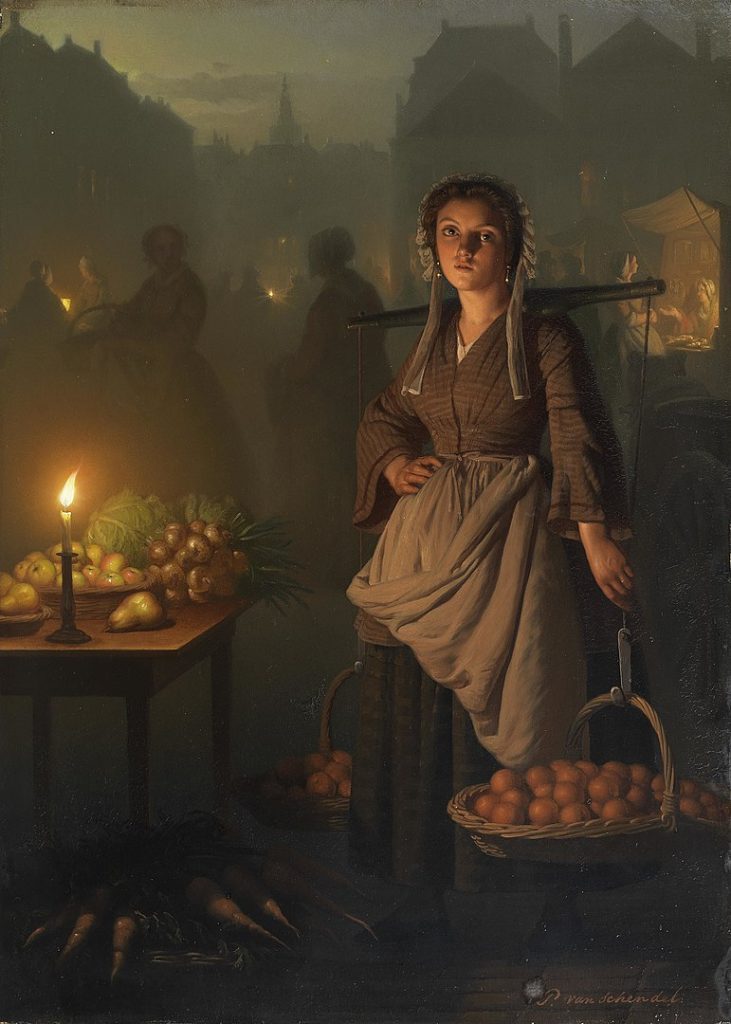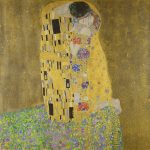
Petrus van Schendel’s Market by Candlelight exemplifies 19th-century art’s ability to elevate the everyday into something magical and profound. Known for his fascination with nocturnal scenes, van Schendel crafted detailed depictions of nighttime markets illuminated solely by candlelight, a focus that gave his work a distinctive and captivating atmosphere. His mastery over light and shadow allowed him to portray lively market scenes that were infused with both warmth and intimacy, qualities that continue to draw audiences today.
The Life and Legacy of Petrus van Schendel
Born in 1806 in Terheyden, Netherlands, Petrus van Schendel displayed artistic talent from a young age, eventually studying at the Royal Academy of Fine Arts in Antwerp. During his training, he developed a foundation in realism and experimented with techniques that could evoke mood and depth, particularly through the manipulation of light. This focus led him to develop a unique style centered around candle-lit scenes, which became his signature approach. Throughout his career, van Schendel gained a reputation as the “Master of Candlelight,” producing works that offered a rare glimpse into the vibrant yet intimate world of 19th-century markets after dark. His ability to infuse ordinary scenes with emotional resonance set him apart from his peers, making him a defining artist of his era.
The Enchanting Scene in Market by Candlelight
In Market by Candlelight, van Schendel captures the essence of a bustling nighttime market, where vendors, shoppers, and an array of goods are illuminated by the warm glow of candles. Unlike traditional daytime scenes that focus on showcasing a variety of products, this night market invites viewers to engage with the people and their interactions. The candlelight draws attention to the expressive faces of the characters, casting a gentle warmth across each figure’s features, hands, and wares. The interplay between light and shadow in the painting emphasizes not only the physical details but also the underlying emotion of the scene, making it feel both lively and intimate.
At the heart of Market by Candlelight is van Schendel’s extraordinary attention to detail. His market scenes often depict individuals in traditional dress, and each figure is painted with realistic expressions and postures, capturing a snapshot of daily life. In these scenes, women in scarves and dresses inspect produce, children watch the activity with curiosity, and merchants lean toward their customers to negotiate or chat. The candlelight, which selectively illuminates parts of the scene, draws the viewer’s eye to these interactions, making them feel personal and inviting. This focus on realism allows the viewer to experience the scene not just as a spectator but almost as a participant in the market.
Van Schendel’s Mastery of Chiaroscuro
One of the defining features of van Schendel’s work is his expert use of chiaroscuro, a technique that creates depth and volume through contrasts between light and dark. Originating during the Renaissance, chiaroscuro allows artists to render three-dimensional scenes on two-dimensional surfaces. In Market by Candlelight, van Schendel employs this technique by using candlelight as the sole source of illumination, casting vivid highlights on faces and figures while leaving much of the background in shadow. This approach not only directs the viewer’s attention to specific details within the scene but also creates an immersive effect, as if the viewer were standing amidst the crowd under the flickering light.
The symbolism of candlelight in van Schendel’s work goes beyond practical lighting. In many ways, the candles serve as a metaphor for warmth, community, and shared humanity. The soft, diffused light brings the figures together in a cocoon of intimacy, highlighting the closeness and connection between individuals within the market. This warm illumination contrasts sharply with the darkness that surrounds the market, suggesting that these moments of connection are a light against the broader unknown, adding a layer of emotional depth to the painting.
A Lasting Influence and Romantic Legacy
Van Schendel’s fascination with light, shadow, and everyday life places him firmly within the Romantic tradition. Romanticism celebrated the beauty and emotion of ordinary experiences, and van Schendel’s market scenes capture both the vibrancy and simplicity of nightly exchanges. His use of candlelight reflects the Romantic ideal of finding beauty in fleeting moments, allowing viewers to connect with his subjects on a personal level. In portraying these markets, he did more than depict commerce; he highlighted the universal themes of community and connection, showcasing the market as a place where lives intersect and stories unfold.
By focusing on scenes that emphasized warmth and humanity, Petrus van Schendel created works that feel timeless. His Market by Candlelight series remains beloved not just for its technical skill but also for its ability to capture an aspect of life that resonates across generations. Each painting invites the viewer to step back in time and experience the beauty of an ordinary evening, illuminated by candlelight and filled with the hum of human life.
Key Takeaways:
- Market by Candlelight by Petrus van Schendel captures the vibrancy of night markets using candlelight as the sole illumination source.
- Van Schendel’s mastery of chiaroscuro emphasizes depth, making scenes appear three-dimensional and drawing focus to specific interactions.
- The candlelight serves as both a literal and symbolic source of warmth and community, highlighting shared human experiences.
- As a Romantic artist, van Schendel’s work celebrates the beauty of ordinary moments, making his scenes timeless and deeply resonant.
FAQs
- Who was Petrus van Schendel?
Petrus van Schendel was a 19th-century Dutch-Belgian artist renowned for his nocturnal market scenes illuminated by candlelight. - What makes Market by Candlelight unique?
The painting’s unique appeal lies in its use of candlelight to highlight figures, creating a warm and intimate atmosphere that contrasts with the darkness surrounding the market. - Why is candlelight significant in van Schendel’s work?
Candlelight in his work symbolizes warmth, connection, and community, bringing focus to the interactions and humanity of his subjects.




